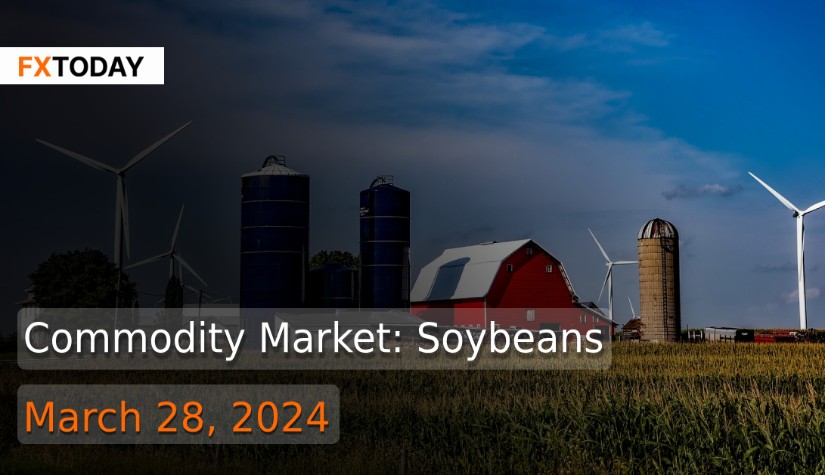Soybean Market Remains Under Pressure
The soybean market experienced moderate declines due to fund and technical selling pressures. This decline was also influenced by spillover effects from bean oil and palm oil markets. Soybean meal prices were mixed but eventually closed lower, influenced by the movements in soybeans and bean oil.
Brazil's ongoing harvest maintained its price advantage over the U.S. However, Brazil's average yields are reported to be below the previous year, as expected due to challenges during planting and development. Market watchers are eagerly awaiting the USDA's upcoming supply, demand, and production figures, scheduled for release on April 11th, along with CONAB's updated outlook for Brazil.
ANEC (National Association of Cereal Exporters) reported slightly lower than expected soybean exports from Brazil for March, while long-term logistical concerns stemming from the collapse of Baltimore's France Scott Key Bridge are also weighing on the market sentiment.
Looking at the U.S. soybean supply and use outlook for 2023/24, projections remain unchanged. However, soybean oil prices are reduced slightly. Global oilseed production for the same period is revised downward, mainly due to lower soybean and sunflowerseed production, partly offset by higher rapeseed output. Soybean production in Brazil and South Africa is reduced, affecting global supply and demand forecasts, with lower ending stocks projected.
A study conducted by the USDA Economic Research Service modeled the impact of climate-linked changes on future U.S. corn and soybean yields, affecting markets and trade through the mid-2020s. The study projects a decline in soybean exports but an increase in corn exports by 2036 due to changing climate conditions.
There's a shift in the U.S. agriculture landscape towards soybeans driven by President Biden's decarbonization plan and the growing demand for renewable diesel. This could potentially dethrone corn as the dominant crop in the future, with soybeans taking the lead.
However, some skepticism remains regarding soybeans becoming the primary crop, as many farmers still prefer planting corn due to its seasonal advantages and ease of harvest. Despite this, analysts predict an increase in soybean planting in 2024, although corn still dominates in planned acreage.
An agribusiness consultancy projects Brazilian soybean production to reach 156.5 million metric tons this year, attributing the increase to expanded planted areas. Despite initial climate uncertainties, the country's soy area may see a slight decline next season, marking the first reduction since 2006. Meanwhile, dry weather in Argentina's key agricultural regions is expected to facilitate the start of soy and corn harvests following recent heavy rains, according to the Buenos Aires Grains Exchange.
In Bangladesh, soybean oil consumption is declining due to increased demand for cheaper alternatives like mustard and palm oils. Government initiatives have boosted mustard cultivation, reducing the demand for soybean oil.
Amidst ample U.S. supplies and the likelihood of increased soybean plantings, market sentiment remains cautious. The soybean markets are experiencing technical selling pressure as traders anticipate USDA reports while grappling with uncertainties surrounding the recent outbreak of Highly Pathogenic Avian Influenza (HPAI) and the closure of the Baltimore port, along with weak soybean oil prices attributed to profit-taking in palm oil futures.
Despite the prevailing bearish sentiment, there are indications of potential bullish trends, particularly in the soybean market, where prices are supported by technical factors such as the EMA50 providing positive support and stochastic indicators reaching oversold levels. This suggests a corrective bullish trend, with a target set at $1231.20, although a breach of $1193.10 support could signal a return to the main bearish track. The expected trading range for the period is between $1190.00 support and $1220.00 resistance.
Data for Technical Analysis (1H) CFD US Soybeans Futures - May 24 (ZSK4)
Resistance : 1191.49, 1192.20, 1193.50
Support : 1189.01, 1188.24, 1187.00
1H Outlook
Source: TradingView
Buy/Long 1 If the support at the price range 1187.01 - 1189.01 is touched, but the support at 1189.01 cannot be broken, the TP may be set around 1192.25 and the SL around 1186.00, or up to the risk appetite.
Buy/Long 2 If the resistance can be broken at the price range of 1191.49 - 1193.49, TP may be set around 1195.70 and SL around 1188.00, or up to the risk appetite.
Sell/Short 1 If the resistance at the price range 1191.49 - 1193.49 is touched, but the resistance 1191.49 cannot be broken, the TP may be set around 1189.00 and the SL around 1194.50, or up to the risk appetite.
Sell/Short 2 If the support can be broken at the price range of 1187.01 - 1189.01, TP may be set around 1185.75 and SL around 1192.50, or up to the risk appetite.
Pivot Points Mar 28, 2024 03:04AM GMT
|
Name
|
S3
|
S2
|
S1
|
Pivot Points
|
R1
|
R2
|
R3
|
|---|---|---|---|---|---|---|---|
| Classic | 1185.75 | 1187 | 1189 | 1190.25 | 1192.25 | 1193.5 | 1195.5 |
| Fibonacci | 1187 | 1188.24 | 1189.01 | 1190.25 | 1191.49 | 1192.26 | 1193.5 |
| Camarilla | 1190.11 | 1190.4 | 1190.7 | 1190.25 | 1191.3 | 1191.6 | 1191.89 |
| Woodie's | 1186.13 | 1187.19 | 1189.38 | 1190.44 | 1192.63 | 1193.69 | 1195.88 |
| DeMark's | - | - | 1189.62 | 1190.56 | 1192.88 | - | - |
Sources: Nasdaq, Economies.com
















